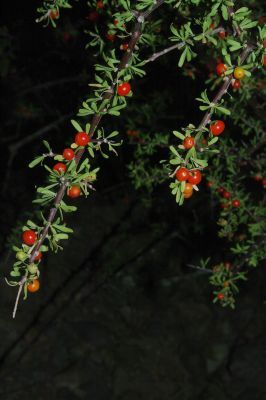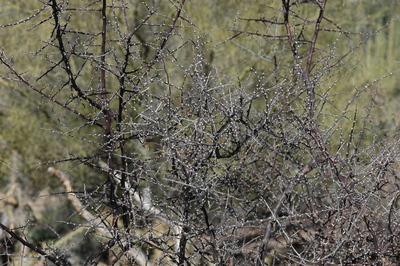

Names
Scientific Name: Lycium berlandieri
Synonym:
Common Names: Berlandier’s wolfberry, boxthorn, desert thorn, barchata, joso, cilindrillo
Characteristics
Duration: Perennial
Growth Habit: Shrub
Arizona Native Status: Native
Habitat: Desert, upland, riparian. This plant grows in a variety of habitats including desert flats, washes, grasslands, sandy hills, and rocky slopes from 2,100 to 4,600 feet.
Flower Color: Small greenish to purplish flowers
Flowering Season: March to September
Height: 2 to 8 feet, depending upon water availability
Description: The foliage of this plant is densely branched and spiny. Wolfberry is leafless during dry seasons, but refoliates quickly with rain. Axillary flowers are bell-shaped, appearing individually or clustered. The structure of the flowers suggests that bees are a favored pollinator, but they are also popular with butterflies and hummingbirds. Pea-sized berries resembling tiny tomatoes follow the flowers. Average life span of wolf berry is 90 years.
Special Characteristics
The berries of Lycium are popular with birds. Gambel’s quail use the plant as a food source, as well as for cover, roosting, and nesting. People enjoy the berries as well, though insect larva may be harbored within.
Classification
Order: Solanales
Family: Solanaceae
SOURCES:
Matthews, Robin F. 1994. Lycium berlandieri. In: Fire Effects Information System, [Online]. U.S. Department of Agriculture, Forest Service, Rocky Mountain Research Station, Fire Sciences Laboratory (Producer). Available: http://www.fs.fed.us/database/feis/ [2013, October 1].
Phillips, S. J. and P. W. Comus. 2000. A Natural History of the Sonoran Desert. Tucson: Arizona-Sonora Desert Museum Press.
